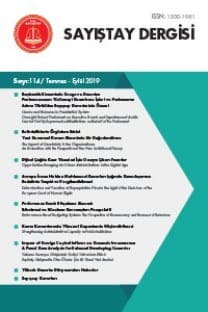Teoriden Uygulamaya Dış Yardım
Dış Yardım, Etkinlik, Küresel Kalkınma, Paris Deklarasyonu
FOREIGN AID FROM THEORY TO PRACTICE
Foreign Aid, Effectiveness, Global Development, Paris Declaration,
___
- Davutoğlu, Ahmet (2008), Stratejik Derinlik, Küre Yayınları, İstanbul.
- Development Assistance Committee (1991), “Principles for Evaluation of Development Assistance”, OECD, Paris.
- Development Assistance Committee (2008), “Is It ODA?”, OECD, Paris.
- Karagöz, Ferda (2010) “Yoksulluk Tuzağı ve Dış Yardım: Eleştirel Bir Yaklaşım”, Sosyal Bilimler Dergisi, Sayı 2010/1.
- Kattel, Rainer, Kregel Jan ve Reınert Erik (2011), Ragnar Nurkse (1907-2007), Classical Development Economics and its Relevance for Today, Anthem Press, UK.
- Kulaklıkaya, Musa (2008) “Kalkınma Yardımında Dünyadaki Son Trendler ve TİKA”, Uluslararası Ekonomik Sorunlar Dergisi, Sayı 31.
- Lancaster, Carol (2007), Foreign Aid: Diplomacy, Devolepment, Domestic Politic, University of Chicago, USA.
- OECD (2008), The Paris Declaration on Aid Effectiveness and the Accra Agenda for Action 2005/2008, OECD, Paris.
- OECD (2009), Better Aid, Managing Aid, Practices of DAC Member Countries, OECD, Paris.
- OECD (2012), “50 Years of Official Development Assistance”, http://www.oecd.org/ document /41/0,3746,en_2649_34447_46195625_1_1_1_1,00.html (Erişim Tarihi:16.6.2012)
- OECD (2011), “Fourth High Level Forum on Aid Effectiveness”, http://www.oecd.org/ document/12/0,3746,en_2649_3236398_46057868_1_1_1_1,00.html (Erişim Tarihi: 16.7.2012)
- OECD (2012), “ODA By Donor”, http://stats.oecd.org/Index.aspx?DatasetCode=ODA_ DONOR (Erişim Tarihi: 16.6.2012)
- OECD (2012), “Official Development Assistance From DAC and Other OECD Members In 2011”, OECD, Paris.
- OECD (2011), Aid Effectiveness 2005–10: Progress in Implementing the Paris Declaration, OECD, Paris.
- Roodman, David (2004), “An Index of Donor Performance”, Center for Global Development, Working Paper Number 42, Washington D.C.
- Sogge, David (2002) Give and Take: What’s the Matter with Foreign Aid, Fernwood Publishing, Canada
- Thorbecke, Eric (2000) “The Evolution of Development Doctrine and the Role of Foreign Aid, 1950-2000”, Foreign Aid and Development F.Trap (der.), Routledge, Londra.
- Twain, Mark (2001), “Corruption and Growth”, The Elusive Quest for Growth W. Easterly (der.), The MIT Press, Londra.
- United Nations (2000), “UN Millennium Declaration”, General Assembly, 55/2. http://www.un.org/millenniumgoals/ (Erişim Tarihi: 4.4.2012)
- United Nations (2003), “International Conference on Financing for Development (18-22 Mart 2002)”, Monterry, Mexico.
- Walle Nicolas, Pettersson Gunilla, Moss Todd (2006), “Aid-Institutions Paradox?”, Center For Global Development, Working Paper Number 74, Washington D.C.
- Wood B., D. Kabell, F. Sagasti ve N. Muwanga (2008), Synthesis Report on the First Phase of the Evaluation of the Implementation of the Paris Declaration, Danimarka Dışişleri Bakanlığı, Kopenhag.
- World Bank (1997), “AnnualReview of Development Effectiveness”, (Erişim Tarihi: 10 Ocak 2012)
- World Bank (1998), Assessing Aid, Oxford University Press, Washington D.C.
- Yardım Heyeti Başkanlığı (2012), “2011 Yılı Faaliyet Raporu”, Yardım Heyeti Başkanlığı, Lefkoşa.
- ISSN: 1300-1981
- Yayın Aralığı: 4
- Başlangıç: 1990
- Yayıncı: T.C. Sayıştay Başkanlığı
Teoriden Uygulamaya Dış Yardım
Yerel Yönetimlerde Yolsuzlukla Mücadelede Yönetişim İlke ve Uygulamaları
M Akif ÇUKURÇAYIR, M Akif ÖZER, Kasım TURGUT
ASOSAI Bölgesinde Gelişen Çevre Denetimi: 4. ASOSAI Çevre Denetimi Seminerinden Notlar
Denetimde Yazılım Araçlarının Kullanılması Konulu EUROSAI Semineri
2000 Yılı Sonrası Türk Tarım Sektöründe Yapısal Dönüşüm Politikaları
E Emrah HATUNOĞLU, Feyza ELDENİZ
Yüksek Denetim Kuruluşlarının Denetim Kapsamı
Metin BAYRAK, Mehmet Alpertunga AVCI
